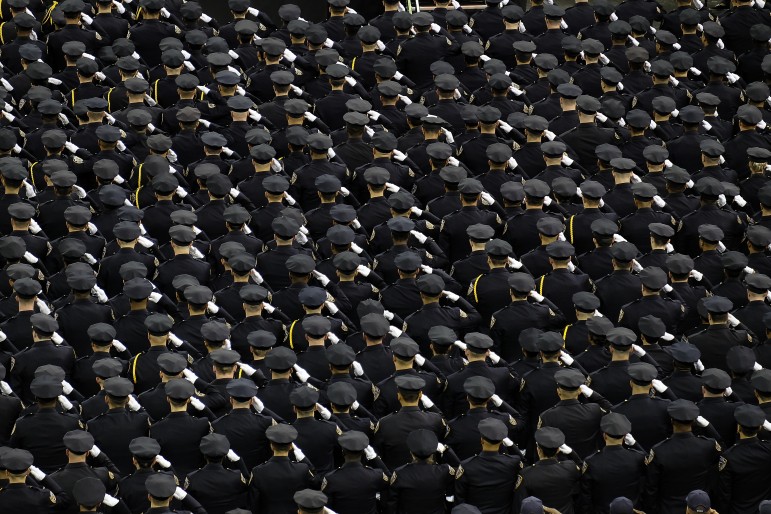
Diana Robinson/Mayoral Photography Office
In one of New York City’s rarest criminal justice events, a Bronx cop is facing prison time for perjury. New York Police Department’s Michael Ackermann, 32, was convicted of a felony last month, for lying about the circumstances of the 2012 arrest of Robert Stolarik, a New York Times photographer. Stolarik was taking pictures of Ackermann making an arrest, and was placed in cuffs himself, allegedly for interfering.
In papers filed with the court, Ackermann claimed that Stolarik was continuously discharging his camera flash in the officer’s face and distracting him. One problem: the shutterbug’s Nikon D4 camera did not actually have a flash. The case against Stolarik was eventually dismissed. Last year 150,215 cases ended similarly, with a dismissal, an adjournment in contemplation of dismissal or an acquittal – 41 percent of all cases in New York City.
But here’s where this case took an unusual turn. In August 2013, a year after the initial encounter within the friendly confines of the 43rd Precinct, Bronx District Attorney Robert Johnson had Ackermann arrested, and indicted him on a variety of felony and misdemeanor charges relating to tampering with public records, falsifying written statements and official misconduct. This never happens.
The establishment of Broken Windows-style policing, which in New York City under commissioners William Bratton (twice) and Ray Kelly meant an almost unfathomable amount of arrests of black and Latino New Yorkers for low-level crimes and infractions, has dramatically changed the composition of charges brought before judges in Criminal Court.
In many low-level cases, cops are the only witnesses, as they rabidly enforce nuisances such as open container, fare-beating, marijuana possession and staying in the park after dark. There typically are not civilian complaining witnesses in these arrests, and the criminal case comes down to the word of the police officer against the word of the person who has been arrested. How often the police manufacture justifications for these types of arrests is unknown, because these low-level cases rarely get to trial, where the officer’s testimony would receive scrutiny from someone – judges and public defenders – outside the NYPD or the various District Attorneys’ offices.
Consider this: Last week in Brooklyn Criminal Court a man was charged with tampering with evidence and marijuana possession. The District Attorney’s office alleged that the man, 57 years-old and Latino, was smoking a joint in public and tossed it when cops arrived. The joint was never recovered, but NYPD searched him and found a dime bag of weed in his pocket; that’s not a crime, but NYPD arrested him anyway. Twenty-four hours later the man told the judge that he was smoking a cigarette. His defense attorney suggested the joint was fabricated to provide a plausible pretext for a search of an otherwise innocent man; manufacturing legal cause for stop-and-frisk. The man eventually took a plea to disorderly conduct. Did the cops fabricate the joint? We’ll never know.
It’s common knowledge that district attorneys frequently look the other way when they suspect a police officer may have cut corners or outright fabricated accusations. (See: Scarcella, Louis)
Judge Alex Kozinski of the United States Court of Appeals for the Ninth Circuit has said: “It is an open secret long shared by prosecutors, defense lawyers, and judges that perjury is widespread among law enforcement officers … police lie to avoid letting someone they think is guilty, or they know is guilty, go free.”
I. Bennett Capers is a former prosecutor who now sits on New York City’s Civilian Complaint Review Board. The CCRB is ostensibly and oversight panel of the NYPD though its independence has been widely questioned due to the close personal relationship between its Chair Richard Emery and the administration of Mayor Bill de Blasio. Emery is also close personal friends with NYPD Chief William Bratton; Emery’s son works for the NYPD.
“At the Southern District of New York,” Capers told me two years ago, “if we really thought that an officer had lied, and we had evidence or a judge had made a finding on the record that the officer had lied, our response was to keep using that officer. We’d avoid bringing him to the stand, we’d call his partner rather than him, but we’d never take the next step of filing a perjury case because that might mean he’d lose his job.”
Every once in a while a judge will make a finding that, as a matter of law, the police misrepresented the facts of the case, but these are rarely, if ever, followed up with arrests. Late last year a Brooklyn Judge dismissed gun charges against Jeffrey Herring, who claimed that police officers in the 67th precinct had planted the gun they “found” on him. One of the officers who had arrested Herring, Lt. Edward Babington, along with several peers, had previously been found by a judge to have “perjured themselves” in a similar case.
Nevertheless, Brooklyn District Attorney Ken Thompson pursued the case against Herring. After the New York Times exposed the officers and Herring’s case was dismissed, Thompson said he would investigate the 67th precinct. Ten months later, there has been no news as to any arrests, for either the gun-planting, or lying in court. If not on principle, you’d at least think Thompson would have rung up a couple of these cops for making him look like an idiot for pursuing the cases based on apparent lies.
Ackermann’s case against Stolarik never got to trial, but the Johnson, the Bronx District Attorney, nevertheless took the very rare step of indicting the officer for making up the justification for the arrest. Who he arrested might have had something to do with it. Scott Greenfield is a defense attorney who runs the blog Simple Justice. After Ackerman was convicted I asked him what prompted the DA to charge this officer and not others? Greenfield tweeted back: “That he was a @nytimes photog.”
“It’s good that there was a prosecution at all,” Greenfield wrote about Ackermann. “It’s good that there was a conviction. But this still bears the stench of the ‘one bad apple’ excuse rather than a paradigm shift of its being unacceptable that cops lie. Rather than reflecting a serious take that perjury by police officers will no longer be tolerated, it emits the unpleasant odor of the exception that proves the rule.”
That different people are afforded different treatment in the criminal justice system axiomatic, if not something of a tautology. But does the treatment of the arresting officers in cases such as those of Stolarik or more recently James Blake,provide a look under the hood of a system that is more and more publicly being outed as oppressive, racist and unfair. Is this why law enforcement contact so furiously focuses on communities already marginalized by a host of public policies and private divestment? Because they can get away with it and because the repercussions of arresting the more privileged among us has such an obvious downside?








